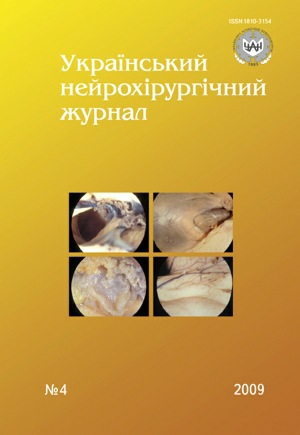The use of discography in the diagnosis of lesions in the thoracic spine hernia
DOI:
https://doi.org/10.25305/unj.108014Keywords:
thoracic spine, disk hernia, discographyAbstract
In order to improve the diagnosis of thoracic intervertebral discs’ hernia, the results of 20 patients, surgically treated from 1999 to 2009 years have been analyzed. For diagnostics discography was used. For estimation of motor, sensitive, pelvic disorders, pain syndrome intensiveness, patient’s functional status we used a scale of thoracic mieloradiculopathy, which characterizes the patient’s state by one number. At patients, whom discography was applied for diagnostics, statistically significant increase of low functional deficits frequency was observed. Discography appeared to be useful for surgical intervention planning on thoracic spine, for example, stabilizing transactions, any percutaneous decompressive operations performing and repeated surgical interventions on spine. Discography — is very informative and relatively safe diagnostics method.
References
Akhaddar A., Gazzazz M., Kadiri B. et al. Chronic lumbar pain considered to be “Nephritic colic” after seven years, due to a thoracic disc herniation at T10–11 // Ann. Urol. — 2003. — V.37. — P.173–176.
Cloward R.B., Busade L.L. Discography: Technique, indications and evaluation of the normal and abnormal intervertebral disc // Am. J. Roentgenol. — 1952. — V.68. — P.552–564.
Hirsch C. An attempt to diagnose level of disc lesion clinically by disc puncture // Acta Orthop. Scand. — 1948. — V.18. — P.132–140.
Lawrence J.S. Rheumatism in populations // Medical Books / Ed. W. Heineman. —London: Hainemann, 1977 — P.80–81.
Lindblom K. Diagnostic puncture of intervertebral discs in sciatica // Acta Orthop. Scand. 1948. — V.17. — P.231–239.
Linton S.J., Hellsing A.L., Hallden K. A population based study of spinal pain among 35 to 45 year old individuals // Spine. — 1998. — V.23. — P.1457–1463.
Manchikanti L., Boswell M.V., Singh V. et al. Comprehensive review of neurophysiologic basis and diagnostic interventions in managing chronic spinal pain // Pain Physician. — 2009. — V.12, N4. — Р.71–120.
Manchikanti L., Helm S., Singh V. et al. An algorithmic approach for clinical management of chronic spinal pain // Pain Physician. — 2009. — V.12, N4. — Р.225–264.
Shah R.V., Everett C.R., McKenzie-Brown A.M., Sehgal N. Discography as a diagnostic test for spinal pain: a systematic and narrative review // Pain Physician. — 2005. — V.8, N.2. — P.187–209.
Singh V., Manchikanti L., Shah R.V. et al. Systematic review of thoracic discography as a diagnostic test for chronic spinal pain // Pain Physician. — 2008. — V.11, N5. — P.631–642.
Trescot A.M., Datta S., Schultz D.M. et al. Interventional techniques: evidence-based practice guidelines in the management of chronic spinal pain // Am. Soc. of Intervent. Pain Physicians // Pain Physician. — 2007. — V.10, N1. — P.7–111.
Downloads
Published
How to Cite
Issue
Section
License
Copyright (c) 2009 E. I. Slynko, A. M. Zolotoverkh

This work is licensed under a Creative Commons Attribution 4.0 International License.
Ukrainian Neurosurgical Journal abides by the CREATIVE COMMONS copyright rights and permissions for open access journals.
Authors, who are published in this Journal, agree to the following conditions:
1. The authors reserve the right to authorship of the work and pass the first publication right of this work to the Journal under the terms of Creative Commons Attribution License, which allows others to freely distribute the published research with the obligatory reference to the authors of the original work and the first publication of the work in this Journal.
2. The authors have the right to conclude separate supplement agreements that relate to non-exclusive work distribution in the form of which it has been published by the Journal (for example, to upload the work to the online storage of the Journal or publish it as part of a monograph), provided that the reference to the first publication of the work in this Journal is included.









